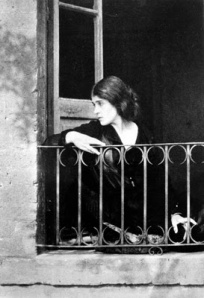Early days of photo: 5 sharp Women
Since the beginning of photography, women have made significant contributions to the medium of photography; below, Rise Art introduces five of these remarkable women, whose work has had an impact on today’s artists.
Claude Cahun (1894-1954)
Lucy Schwob, who later took on the name Claude Cahun as hommage to her great-uncle, was a French artist, encompassing theater, writing and photography. Although she considered herself mainly a quick-change artist, she was an outstanding photographer. With her androgynous name, look and joy in re-inventing herself, she captured gender issues and played with both, gender and sexuality. Her self-portrayed and self-exposing work strongly influenced later generations of artists such as Cindy Sherman, Sophie Calle or Nan Goldin.
Tina Modotti (1896-1942)
Aged 16, Italian-born model, actress and later photographer Assunta Modotti joined her father in San Francisco. Moving to Los Angeles, she met Edward Weston, who – it is said – taught her photography as a means of documentation and fine art. Together with Weston, Modotti moved to Mexico in 1922, where they quickly integrated into the bohemian circles; among their friends were Frida Kahlo and Diego Rivera. Five years later, she joined the Communist Party, marking the date in which her work turns more politically motivated and Tina turning into a political activist.
Berenice Abbott (1898-1991)
A pupil of Man Ray’s, Berenice Abbott’s work as portrait-photographer quickly became as sought after as her instructors. Peggy Guggenheim became a client and supporter. After spending a few years in Paris, the American went back to New York, where she created the body of work she is best known for – black and white photography of the city, illustrating the development of technology and society. In addition to these works, she made important contributions to scientific photography, as well as inventing aides for photography, such as the ‘autopole‘.
Lee Miller (1907-1977)
Elizabeth ‘Lee’ Miller, later Lady Penrose was an American born fashion model in New York City before going to Paris to become a successful photographer. Man Ray was her mentor and lover. It is said she helped Man Ray discover the process of ‘solarisation‘ in photography (look at the portrait of Lee Miller above), thereby contributing its further development. Not only was she an acclaimed fashion and portrait photographer, but also one of the few women who documented events such as the liberation of Paris and the London Blitz as well as concentration camps.
Inge Morath (1923-2002)
Austrian-born Inge Morath was among the first female members of Magnum Photos, which to this date remains male dominated. Morath married the playwright Arthur Miller and relocated permanently to the States. Among her most important achievements in photography are her portraits, as she created the idea of taking people in intimate settings. Philip Roth, a writer and one of her subjects, describer Morath as ‘the most engaging, sprightly, seemingly harmless voyeur I know.’
Research Resources: Top 10 London Libraries
For many artists research is a crucial starting point to the creation of new work. At Rise Art, we compiled a list of London Libraries our team enjoys, maybe there are some among them that you have not heard of yet?
- Courtauld Institute of Art Book Library The Art Book Library collection covers the history of art in the western tradition from classical antiquity to date.
- Witt Library is an image Library, consisting of a collection of reproductions of western art, after paintings, drawings and prints from 1200 to the present day. It is situated in the Courtauld Institute.
- The Paul Mellon Centre for Studies in British Art is an educational charity aiming to promote and support the study of British history of art and architecture. Apart from a library, the centre offers a range of activities, such as lectures, and also grants!
- Tate – Archive Journeys is the beginning of the aim to provide online access to parts of its remarkable Archive. These journeys through three themes from the Tate Archive provide a fascinating insight into Tate’s History, the Bloomsbury Group and the art world of the 1960s and 70s as seen through the eyes of the art critic Barbara Reise. We are looking forward to the further development of these archives!
- St Bride Library is also referred to as ‘printing’ library, as its collections cover printing and related subjects, such as paper and binding, graphic design and typography, illustration and printmaking, as well as publishing, book-selling and the social and economic aspects of printing.
- National Art Library located at the Victoria & Albert Museum is a major public reference library. Its strength lies in the range and depth of its holdings of documentary material
concerning the fine and decorative arts of many countries and periods. - The Woman’s Art Library (MAKE) in the Goldsmiths College main purpose is to provide a place for woman artists to deposit unique documentation of their work, thereby facilitating the study of work by women artists.
- The World Wide Web Virtual Library: History of Art is a collection of links relating to Art History and computer applications in Art History. The site is sponsored by CHArt, the Computers and History of Art Group. This site is especially focused on the academic study of Art History.
- ARLIS UK & Ireland is the professional organisation for people involved in providing library and information services and documenting resources in the visual arts.
- The British Library is the most extensive Library in this country.
Which libraries in London or the UK do you enjoy doing your research in? Go ahead, add them to the list and share your experiences!






leave a comment